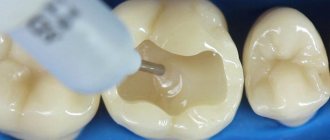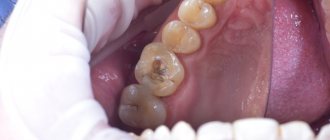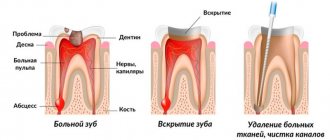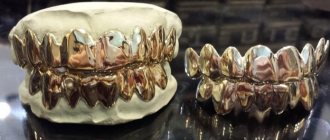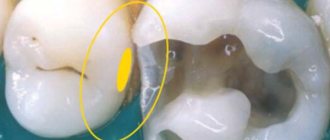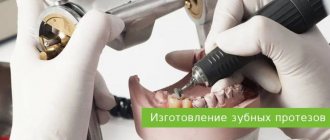Many dental clinics offer fillings using several different filling materials. Price lists (including those posted on websites) are also often replete with various commercial names of fillings: Filtek, Spectrum, Aesthetics, Charisma (Karizma), Vines (Venus), Gradia, Estelite, Herculite, Point, Tetrik, Admira, Brilliant, Enamel Plus and others. Patients are asked to make a choice, but this requires dental-level knowledge, which most people, of course, do not possess.
Popular articles on the Internet for the following queries: “which filling is better?”, “which filling material is the best?”, “which filling is better to put?” and so on. – do little to clarify the situation. Most articles (often written by anonymous authors or copywriters) discuss only classes of filling materials: cements, amalgams, glass ionomers, chemical and light-curing composites. After a detailed description of materials that went out of use several decades ago (apparently to give more volume to the text), the conclusion is made that light-curing composites are the best, and if a person has the financial means, then it is advisable to install fillings from them. Either nothing is mentioned about specific brands of heliocomposites, or it is stated that they are all approximately equally good. Or “the latest generation nanocomposites” begin to be advertised.
What fillings do not need to be placed?
The first and most important thing that every patient should understand is that light-curing fillings (photopolymers, heliocomposites) are the only reasonable choice in the 21st century. Even for people on a budget. Other materials are not 10 or 20 percent, but many times worse. Discussing the advantages or price/quality ratio of cement fillings in our time is as stupid as looking for advantages, for example, in reel-to-reel tape recorders. For a long time now, no one has been producing or buying cassette and video recorders, but for some reason some individuals allow themselves to install a 19th-century seal.
Plastic fillings are completely beyond reason. Acrylic oxide and similar anachronisms should have been banned for use a quarter of a century ago, since they are not only unable to stop the further spread of caries, but also provoke its progression. A plastic filling on a tooth is a direct road to pulpitis and periodontitis. You have to hate yourself with a fierce hatred to allow this to happen to you. And clinics that currently use such materials will be deprived of their license.
Amalgam fillings are famous for their durability, but due to toxicity (not for the patient, but for the environment and medical staff), dentists themselves refuse them.
Chemical composites are moderately bad - if a person lives from hand to mouth, then, of course, you can install them (it’s still better than nothing). But for most other people who do not experience urgent need every day, this will not be a justifiable choice. It may happen that such a filling will last for many years, but more often the opposite happens. After 3-5 years (or earlier), caries will develop under the “chemical” filling, and it can either reach pulpitis, or the amount of destruction will become so great that instead of re-installing the filling, the manufacture of an inlay or onlay will be required. As a result, the cost of repeated intervention increases by an order of magnitude due to the savings of thousands of rubles the first time (the approximate difference with the cost of a light-curing composite).
Light curing filling – what is it?
A filling made of light-curing material can be found under the names photopolymer, reflective, polymer, light-hardening. All these terms mean that heliocomposite is used as a filling material, which, under the influence of ultraviolet light, decomposes into radicals and polymerizes.
The main component of the light filling is heliocomposite. In addition to it, the light-curing polymerization composition includes special fillers, which determine the appearance, properties and service life of the structure. It can be:
- Macrophiles . Inorganic particles of large and medium size. The main advantages of fillings with their inclusion are high strength and radiopacity, which gives the doctor the opportunity to control the carious process. The disadvantages of such fillings are unstable color and roughness. They are placed on chewing teeth, in the treatment of which the main requirements for filling composite light-curing compositions are strength and safety.
- Microphiles. Small inorganic elements. Fillings with the addition of microfils are easily polished, stable in color and have a glossy sheen characteristic of natural enamel. The disadvantage is low resistance to mechanical loads. Typically, fillings with microfills are used for installation on the front teeth, where the most important issue is the ideal appearance.
- Mini fillers. Compositions with mini-fillers are not highly resistant to mechanical damage, but they are not a brittle material either. They sand poorly and are much less ductile than microfils. Dentists place them solely for the purpose of restoring minor dental defects. Their only advantage, in comparison with other light-curing materials, is their lower price.
- Nanohybrid composites . Ultra-fine particles that combine the best properties of macrophiles and microphiles. Fillings made from light-curing nanohybrid composite are durable, easy to polish, and their color is stable. With their help, you can restore frontal and chewing teeth of varying degrees of damage. The filled area is completely indistinguishable from a natural tooth.
Light-curing fillings are not uniform
Glass ionomer cements with a light-initiated curing mechanism are available. For example, Fuji 2 (Fuji II LC). Compomers (a hybrid material between composites and glass ionomers) are also cured using a lamp. Their most famous representative is Dyract XP. These materials are more reliable than some heliocomposites, but are still significantly inferior to their best representatives. Due to the misconception about the toxicity of composites, some doctors recommend these materials for filling for children. For pediatric dentistry, Fuji and Direct are acceptable options, but composites are still preferable.
Dental composite materials are divided into universal (suitable for filling any cavities), aesthetic for anterior teeth (excellently convey all the nuances of the color of natural teeth) and packable for chewing teeth (have low shrinkage and abrasion, but also low aesthetic characteristics). There is another class of composites – flowable. Previously, they were recommended for filling wedge-shaped defects due to their high elasticity, however, according to modern data, universal composites give better results even with non-carious lesions.1 Therefore, current composites currently have only an auxiliary value: they are used together with other classes of materials, but the main one the volume of the filling does not make up.
Universal heliocomposites are the most widely used type of filling materials in the world. The commercial names of fillings offered to the patient to choose from mostly refer to these materials. They also differ in quality. The percentage of inorganic filler, its chemical composition and the shape of the granules determine the mechanical properties of the filling: polymerization shrinkage, mechanical strength, hardness and wear resistance, polishability and surface smoothness. Some of these parameters antagonize each other. For example, for good polishability, the granules of non-limiting filler (oxides of silicon, zirconium, aluminum, etc.) should be as small as possible, and to increase strength, on the contrary, as large as possible. Therefore, materials advertised as “nanocomposites” cause a wry smile among professionals - the prefix “nano-” attracts illiterate dentists and patients who blindly associate it with high technology. However, for the sake of fairness, quite good material can be presented. For example, Filtek Ultimate.
Photocurable composite materials in aesthetic restoration of permanent teeth
TRADITIONAL PHOTOPOLYMERS
The constituent components of composite materials are an organic monomer and inorganic fillers;
they also contain polymerization initiators, stabilizers, dyes and pigments that determine the quality of the filling. Restorative materials contain the product Bis-GMA (bis-phenol A (diphenylpropane) and glycidyl methacrylate-2). It has a number of positive properties. These are adhesion to tooth tissue, high mechanical strength, chemical resistance, and a low coefficient of thermal expansion. However, being a multi-component mixture, it is difficult to clean. The presence of volatile comonomers increases curing shrinkage. Color stability is insufficient due to the presence of impurities that cannot be removed. The latest generations of photopolymers contain, in addition to BisGMA, monomers UDMA and TEDMA. The organic matrix provides the composition with fluidity during the formation of the filling and stability, solidity, and tightness during operation. The filler forms the mechanical properties of the composition and affects the thermophysical, physicochemical and other properties of the material. Filling polymers with various types of quartz flour, aluminum and lithium silicates, hydroxyapatites, phosphates, borosilicates, etc. makes it possible to increase their rigidity, dimensional stability, in some cases strength and impact strength, improve heat resistance, reduce water absorption, shrinkage, exotherm, and provide the required color. One or more types of fillers can be introduced into the matrix. To achieve adhesion of the filler to the organic matrix, modification of the filler surface is used: finishing (treating the filler surface with special substances) or silanization (creating a polymer shell on filler particles). The interfacial layer significantly affects the properties of the composite. Its thickness is 10–30 µm.
Composites have 1.7 times less shrinkage than acrylic materials, their coefficient of thermal expansion is 4 times lower, their rigidity is 5 times higher, and their compressive strength is 3 times higher. They provide good mechanical retention.
Macrophilic composites include inorganic fillers ranging in size from 2 to 30 microns. Fillings made from macrophilic composites are difficult to polish and their surface changes color.
Microphiles contain small filler (up to 0.04 microns), are less mechanically stable, but are easily polished and retain their natural shine. In terms of optical properties, they are more consistent with enamel.
Hybrid composites are characterized by a variety of fillers, their high concentration and, as a rule, high-quality physical indicators. Materials, which mainly contain particles larger than 5 microns, are similar in basic parameters to macrophilic materials. If there are fillers with a diameter of 1–2 μm, then the composites belong to finely dispersed hybrid compositions, characterized by good optical and physical properties, high radiopacity, convenient consistency and slight abrasion of the filling and the antagonist tooth.
Microhybrids have good strength due to the high content of glass particles as fillers. Microhybrid can be highly polished, but over time the natural shine of the restoration decreases. They are universal and can be used for various types of defects.
The group of hybrid composites includes “Arabesk Top” (VOCO) - a light-curing composite based on BCS (B - bi, C - ceramic, S - system), a combination of two glass-ceramic structures with particles of different sizes. "Arabesque Top" has: natural aesthetics due to the chameleon effect, polishability to gloss, color stability, low shrinkage - 2.49% of the volume, tight edge fit in combination with the Solobond M adhesive system. The hardness of “Arabesque Top” is close to that of enamel, and the elastic modulus is close to dentin. Characterized by minimal abrasion. Available in 7 shades: A2, A3, A3.5, B2, B3, C2, OA2. A universal composite for restoring teeth with cavities of all Black classes, making veneers, color and shape correction, splinting.
An example of a microhybrid composite with an improved matrix is Amaris (VOCO), a highly filled (80% by weight) composite material based on a low-shrinkage methacrylate matrix (Bis-GMA, UDMA, TEGMA). "Amaris" polymerizes under the influence of visible blue light, it can be combined with any modern adhesive systems. Has opaque shades corresponding to the natural colors of dentin (01, 02, 03, 04, 05, Obleach). Enamel shades correspond to natural enamel: TL (translucent light); TN (neutral); TD (dark). Special shades have fluidity: HT (high translucency) and HO (high opacity). Indications for use: aesthetic restoration of carious cavities of classes III, IV and V (front teeth); aesthetic restoration of cavities of classes I, II and V (chewing teeth); reconstruction of traumatic dental injuries; aesthetic correction of color and shape disorders; repair of highly aesthetic veneers (including ceramic); splinting of anterior teeth.
We present a clinical case of veneer production. Opaque layers are applied deep into the cavity, enamel layers are applied in the direction of the vestibular surface (Fig. 1a).
Rice. 1a. A light opaque layer is modeled in the middle and gingival area of the incisor.
Opaque shades must correspond to enamel shades: dark opaque with TD, natural – with similar enamel, light – with TL (Fig. 1b).
Rice. 1b. The enamel layer is modeled in the area of the cutting edge.
The use of HT and HO shades creates high light transmission and high opacity to achieve a customized restoration look. The use of HT composite at the cutting edge will give the structure a unique appearance (Fig. 2).
Rice. 2. Modeling of the cutting edge.
The use of HO shade eliminates surface color irregularities.
"Amaris Gingiva" (Amaris Gingiva, VOCO) is a material containing 80% by weight fillers in a methacrylate matrix and cured by the action of blue light, intended for the treatment of defects in the area of the neck of the tooth and exposed, discolored necks of the teeth, especially in the visible frontal area (Fig. 3).
Rice. 3. Gum recession with exposure of the root of the central incisor.
The system consists of three different colored opaques, as well as a gum-colored composite as a base color. Opaques are designed to cover discolored tooth necks, as well as to match the restoration to a specific gum color (Fig. 4).
Rice. 4a. The root of the tooth is covered with pink photopolymer.
Rice. 4b. The gingival papilla is modeled.
NANOHYBRID MATERIALS
Nanohybrid composites contain polymer resins with high molecular weight and microfillers with an average particle size of 20-30 microns. Combining nanometers with glass-ceramic particles made it possible to increase the share of filler in the material to 87%, which reduced the content of organic resins in the matrix and, accordingly, reduced polymerization shrinkage to 1.57%. Filling the material with nanoparticles ensured high edge stability, easy polishability and good color fastness. Thanks to the chameleon property, the stage of selecting composite syringes is simplified. In some cases, one material may be used. In more complex clinical situations, 2-3 syringes with different color characteristics will be required. Nanocomposites are indicated for filling cavities of classes I-V according to Black, restoring teeth with traumatic injuries and defects in hard tissues of a non-carious nature (restoration of teeth with cavities
Class II of significant size; use in splinting, manufacturing inlays, onlays, adhesive prostheses, restoration of tooth stump).
An example is “Grandio” (Grandio, VOCO) - a nanohybrid composite containing nanometers (particles of zirconium silicate, ≤100 nm in size) with glass-ceramic particles of a hybrid composite, the share of filler in the material composition is increased to 87% by weight and 71.4% by volume . The material has high bending strength and high edge stability. High strength, low shrinkage coefficient (1.57%) provide good marginal adhesion and chewing resistance.
"Grandio" has 15 color shades: A1, A2, A3, A3.5, A4, B1, B2, B3, C2, C3, D3, I, OA2, OA3.5, BL. The material is intended for filling cavities of classes I-V according to Black, aesthetic filling of anterior teeth, correction of the shape and color of teeth, splinting, restoration of the tooth stump for a crown, making inlays and veneers. We present a clinical case of tooth restoration after a chipped crown (Fig. 5).
Rice. 5a. Chipped tooth up to 1/2 crown.
Rice. 5 B. Modeling mamelons with opaque composite.
Rice. 5th century Modeling the cutting edge with enamel layers: light.
Rice. 5g. Modeling the cutting edge with enamel layers: transparent.
MODIFIED COMPOSITE MATERIALS
Ormokers are composite materials based on organically modified ceramics, in which the organic matrix is modified: the composition includes organic polymers, glass ceramics, and polysiloxanes. Positive properties are strength and abrasion resistance; high aesthetic qualities, ability to be polished; color fastness.
The polymerization shrinkage of ormokers is 1.97% by volume. Indications for use: filling carious cavities of all classes according to Black; restoration of anterior teeth for defects of traumatic and non-carious origin; production of inlays and onlays.
Admira (VOCO) is an ormoker containing glass ceramic particles with an average diameter of ?0.7 µm and microfiller particles (silicon oxide) with a size of 0.04 µm. The filler is 78% by weight and 56% by volume. Admira includes color enamel shades: red-brown - A1, A2, A3, A3.5, A4; yellow - B2, B3; gray - C2, C3D, D3; incisal edge - I; opaques: universal opaque - UO, OA2, OA3.5, OB2; special whites - BL(OM), BXL(O) - 22 shades. Ormoker "Admira" has a pronounced chameleon effect and is intended for filling cavities of classes I-V according to Black, aesthetic filling of anterior teeth, correction of the shape and color of teeth, splinting, restoration of the tooth stump for a crown, making inlays and veneers.
FLUID COMPOSITE MATERIALS
They are a less viscous modification of traditional composites. The magnitude of their polymerization shrinkage increases slightly compared to traditional hybrids. They are thixotropic: they retain their shape at rest, do not leak out of the cavity, fill all irregularities, ensuring high-quality adaptation of the subsequent layer of composite and ideal marginal fit of the filling. Liquid CM creates an elastic “cushion” under the filling, compensating for the tension arising under the influence of occlusal load. The advantages of these materials: less viscous consistency; high elasticity; natural transparency; biocompatibility; radiopacity; color stability; compatibility with adhesive systems. Disadvantages: increased polymerization shrinkage; the need to apply a thin layer; low strength. They are used for filling cavities of class V according to Black, small cavities of classes I-III (minimal preparation technique); correction of shape and color in the enamel area; as a gasket in cavities of classes I and II; base layer for photopolymer; elastic gasket to relieve tension and strengthen the bonding layer; when repairing fillings and veneers, fixing ceramic crowns, veneers; splinting mobile teeth; invasive fissure sealing, filling of baby teeth.
This class of materials is represented by “Grandio Flow” (VOCO), containing nanometers (zirconium silicate particles ≤100 nm in size) with glass-ceramic particles of a hybrid composite. The material is characterized by thixotropy and has a chameleon effect. Available in five colors (A1, A2, A3, A3.5, B2) and is suitable for restoration of teeth with cavities of classes III-V, invasive fissure sealing, filling of baby teeth, and use in layer-by-layer restoration techniques (Fig. 6).
Rice. 6a. Using a flowable composite to hold one piece of adhesive tape in place.
Rice. 6b. Using a flowable composite to secure two pieces of adhesive tape.
Flowable ormoker "Admira Flow" (Admira Flow, VOCO), containing glass ceramic particles with an average diameter of ?0.7 microns, microfiller particles (silicon oxide) with a size of 0.04 microns (63% by volume), has optimal thixotropy, does not leak cavities, levels uneven surfaces of the cavity, has high elasticity, is characterized by natural transparency when recreating tooth shades, biocompatibility and low shrinkage (2.92%). The material is available in three shades: A2, A3, A3.5 (Fig. 7).
Rice. 7. The flowable composite camouflages the parapulpal pins.
CONCLUSION
Light-curing composite materials of various classes in a therapeutic dentistry clinic can significantly expand the indications for aesthetic restoration of teeth with defects of carious and non-carious origin. They are used to close diastemas and correct other orthodontic disorders. In the technique of adhesive splinting and prosthetics, photopolymers also provide high quality structures for defective dentition.
The best filling materials (as of 2022)
In the dental world, the greatest authority in the assessment of restorative materials currently belongs to the American publication The Dental Advisor. For the last 12 years (from 2010 to 2022), the highest award in the “universal composites” category has been awarded to the Japanese filling material Estelite Sigma Quick. Selection criteria: percentage of inorganic filler, amount of shrinkage, correspondence of shades to the natural color of the tooth, ease of use, radiopacity, polishability. A survey of dentists showed that they switch to Estelite more often than to other filling materials. Clinical success of Estelite is 99%.2
Among aesthetic composites in 2015, 2016, 2022, according to the same publication, the filling material from Germany, Venus Pearl, took the highest position. Its clinical effectiveness is 91%.3 In 2021, it received the title of “preferred product”. It can also be used for chewing teeth.
In 2022 and 2022, first place in the category of aesthetic composites was taken by the Harmonize material of the American manufacturer Kerr Restorative.4
Other good quality filling materials should also be mentioned. These include those who received awards in 2016-2019: Omnichroma, Brilliant EverGlow, Admira Fusion, Filtek Supreme Plus and Filtek Supreme Ultra.
How to install a light seal
The procedure for installing a light filling is similar to other types of filling; it lasts from 30 minutes to an hour. The shade of the material is first selected using a special scale.
Tooth filling with a light polymerization composition is performed in stages:
- The doctor examines the oral cavity and administers local anesthesia.
- After the anesthesia has taken effect, the dentist removes the tissue affected by caries.
- The tooth is then isolated from adjacent units using cotton swabs. To prevent saliva from getting onto the work surface, a saliva ejector is installed.
- The surface to be treated is thoroughly dried and coated with a special preparation for loosening dentin for 40 seconds. After time has passed, the product is washed off and the surface is dried again. The procedure is performed so that the light-curing composition adheres more firmly to the dental tissue.
- After completing the preparatory work, the doctor proceeds directly to the formation of a light-curing filling. The material is applied in layers. To cure, each layer is dried with an ultraviolet lamp for 1–2 minutes.
- After applying and curing all layers, the dentist begins grinding to create an anatomically correct crown shape that is comfortable for the patient.
- After giving the tooth an optimal shape, its surface is coated with a fluoride-containing protective varnish, which strengthens the enamel and helps the reflective filling to secure itself in the crown of the tooth.
After filling, slight discomfort is possible, but the patient should not experience pain. If the pain does not go away within a day, you need to contact the dentist so that the doctor finds out its cause and eliminates errors in his work.
Rating of filling materials:
| Filling material | Manufacturer | Rated by The Dental Advisor | Year of last assessment |
| Estelite Sigma Quick | Tokuyama Dental (Japan) | 99% | 2021 |
| Herculite Ultra | Kerr (USA) | 98% | 2016 |
| Tetric EvoCeram | Ivoclar Vivadent (Liechtenstein) | 97% | 2017 |
| Harmonize | Kerr (USA) | 96% | 2019 |
| Filtek Supreme Universal Restorative | 3M (USA) | 96% | 2019 |
| Filtek Supreme Plus | 3M (USA) | 96% | 2018 |
| Filtek Supreme Ultra | 3M (USA) | 96% | 2018 |
| Brilliant EverGlow | Coltene (Switzerland) | 96% | 2018 |
| Beautiful II LS | Shofu (Japan) | 96% | 2018 |
| Grandio SO | VOCO (Germany) | 96% | 2012 |
| Gradia | GC (Japan) | 96% | 2007 |
| Omnichroma | Tokuyama Dental (Japan) | 94% | 2020 |
| Beautiful II | Shofu (Japan) | 94% | 2009 |
| Admira Fusion | VOCO (Germany) | 93% | 2019 |
| Venus Pearl | Kulzer (Germany) | 91% | 2021 |
| Premise | Kerr (USA) | 91% | 2005 |
Options for tooth restoration with composite in our clinic
The following are produced from composite materials:
- Tabs. Indicated for severe damage. They do not replace the entire tooth, but only the missing inner part.
- Epoxy, acrylic and photopolymer fillings. Suitable for the treatment of caries and restoration of the coronal part in any area of the oral cavity, including the front.
- Veneers. They are the thinnest overlays glued to the front surface of the damaged crown. As a result, the restored unit acquires a beautiful shape and the desired color. Compared to ceramic analogues, composite onlays are less expensive and do not require tissue preparation. But they need to be sanded once every six months; over time, they absorb dyes, which is why the original snow-white shade fades.
